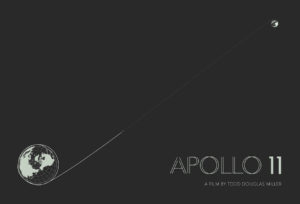Interview with Director Todd Douglas Miller of “Apollo 11”
Written by: Christopher Llewellyn Reed | March 1st, 2019
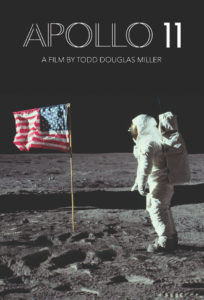
On Wednesday, February 27, 2019, I interviewed director Todd Douglas Miller by phone to discuss his exciting new documentary Apollo 11, edited entirely from archival film footage – some of it shot on 65mm and 70mm film – of the eponymous NASA mission of 1969, which sent astronauts Neil Armstrong, Buzz Aldrin and Michael Collins to the moon. Two of them (Armstrong and Aldrin) were the first humans to walk on its surface (Collins stayed on board the spacecraft, orbiting while his lucky colleagues made cosmic history), and this film takes the viewer from start to finish of the entire voyage, beginning and ending on Planet Earth, with rockets, space and lunar landscapes in between. Director Miller manages quite a lot in just 90 minutes, creating a tale as comprehensive as it is brisk. I saw Apollo 11 at this year’s Sundance Film Festival, placing it among my “10 Documentaries to Watch,” and today it begins its theatrical run. Here is a condensed digest of our conversation, edited for length and clarity.
Christopher Llewellyn Reed: So, this is your fourth feature-length documentary, if I have that right, after Dinosaur 13, Scaring the Fish, and Gahanna Bill. Do you see any kind of through line from the first one up to now?
Todd Douglas Miller: So, Gahanna Bill was my first documentary. That was actually started in film school, so it was really a learning curve of a film. Then, Scaring the Fish, which was many years later, was actually a fiction film, made in just six days, fairly quickly. For all intents and purposes, Dinosaur 13 was really my first feature documentary.
Through the years, I’ve definitely grown as a filmmaker. I joked at one point, with Dinosaur 13, that I was 37 when that came out and it took me that long to just figure out how to do everything. So, I’m certainly in my prime now with Apollo 11. And I am such a fan of large-format film footage, having also shot on film. I started Gahanna Bill on 16mm. We actually also shot some 35mm, as well. That was in the late ’90s, early 2000s. And so it was just really great with this film to work with actual film materials again.
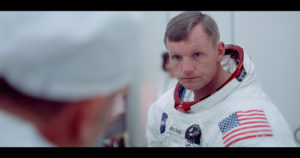
CLR: Great to hear how each one has progressed. Speaking of that large-format film footage – so gorgeous in Apollo 11 – can you talk about how you gained access to that archival material for this film?
TDM: We were endeavoring to undertake a large-scale scanning operation for just the 16mm and 35mm in existence, which was daunting enough. And in the midst of negotiating agreements with the National Archives and researching exactly what that entailed and what it quantified, we discovered this large-format collection.At the time, we believed there to be close to about 100 reels. They all said “Apollo 11” on them, they had dates and they appeared to be in very good condition, but we really didn’t know until we did some test scans. They were housed at College Park, in the National Archives 2 facility outside of DC. The plan was to scan these with a prototype film scanner, a new technology that we wanted to deploy on the project.
I often get asked the question: “Why hadn’t this been discovered until now?” The existence of it was known, but what wasn’t invented yet was the technology to be able to either telecine it or scan it in a reasonable amount of time. Our project represented not only a way in which to do that, but it was also a very unique flavor of large format: it was 65mm, 5 perf, meaning five perforations. And we also had to deal with some 70mm, 10 perforations. So, there were different flavors of it, and this prototype scanner was able to do upwards of 8K resolutions, and the beauty of it was that it rode on a cushion of air. So, we were able to not actually physically touch the negative in any way, outside of just putting the reels up on the scanner.And that’s just a testament to the technological endeavor of the hardware and software guys. And that was just one part of it. We also had to develop new techniques in order to handle it all.
And the same could be said for the audio, as well. During the course of the production, we were alerted to over 18 thousand hours of Apollo air mission control audio; 11 thousand hours of that 18 thousand hours were from Apollo 11. And that was going through the process of NASA’s export control: it was digitized for a speech-recognition project by the University of Texas at Austin. And when we got it, it was kind of a jumbled mess.No one had really wanted to utilize it in media, so we set about working with the team to sync all of that up, which was a Herculean effort spearheaded by a really great technology guy up in Toronto, named Ben Feist, and a few other guys working in conjunction with him. So, before we even got into the creative side of working with these materials, there was just the technical challenge of getting them all organized and then putting them into a timeline that spanned nine days of the mission and seeing where all of these things happened in time. And then we could start tackling the process of creatively telling the story.
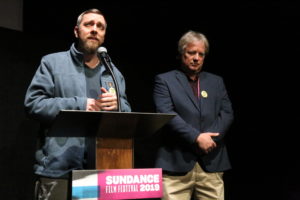
CLR: That’s wonderful. Ben Feist, by the way, I believe is the brother of the singer Feist, correct?
TDM: That’s correct, yes.
CLR: I think the audio work is really phenomenal in this film. But, you, I believe, were the editor. Could you describe your process of whittling down the footage to a very remarkably brisk, yet comprehensive, 90 minutes.
TDM: Well, thank you! It’s just really a testament to the team. I did edit the project, and of course there were long hours involved. The luxury we had with this one was time. And everyone that worked on the project I’d worked with before. We all knew each other’s process, from my audio team to the post-production team to the conformist to the colorist and to my music composer, Matt. So, we all were kind of firing on all cylinders and could go off and work individually on things and then come back and collaborate. It was a project that demanded all of us to be on point, and luckily, we were.
CLR: So, you somewhat answered a question I had about sound, but I still assume that your sound designer, Eric Milano, had to come up with some design or create some sounds that might not have been there, or that you wanted to enhance. Could you describe that process of creating a soundscape out of what you had, and then what you added, too?
TDM: Absolutely. Eric’s work is one of the things I’m most proud about on the film. Originally, we had a whole team spearheaded by Eric, who was going to tackle the 5.1 mix and all the sound design. And then we were going to kick it to our large-format audio mixer, Brian Eimer. As scenes were kind of snapping into focus and I was finishing them, I would give them to Eric and he ended up doing all the, not only the sound design, but the mixing himself; the re-record mix and even the Foley, when needed.
And everything, for the most part, is created from scratch. Obviously, we have the air-to-ground, we have all the historical voice recordings from mission control, we have the onboard audio, and we have the public-affairs officers who were the voices of God, in this case, or that narration in the film. But during the launch sequence, for instance, we had reference audio that wasn’t all that great, but we knew what things sounded like, what individual helicopters sounded like, what trucks sounded like. We were given an 8mm tape that actually had some sound on it that was recorded during the launch from a VIP booth next to a pole that had the PA system on it.
So, it was up to Eric to take that and then enhance it. But we did have reference from some of the later Apollo missions, so Eric would go back and do some Foley to recreate that. If there was someone talking on camera, he could recreate what they were saying by just being an expert in Foley artistry. And certainly, with the Saturn 5 launch, that was a big thing that we tried to get right. And luckily, we were able to test that footage and the audio at the National Air and Space Museum’s IMAX screen – “Did it sound like this?” “What did this feel like?” – and get some immediate feedback. We could then go back to the office in New York, edit some more, show it to them again in a month and get some feedback.
A real case in point was working with NASA’s history department. Bill Barry and his team there were just instrumental in getting the authenticity right. There were two alarms that were going off, a 12:02 and a 12:01 alarm during the landing. I had not seen, in any fiction or non-fiction film, what those were. And I’d never heard that alarm, what it sounded like. And we challenged NASA’s history department, and they went back and they found documentation of exactly what the tone was: it was an 8 kHz tone.So, Eric put that tone in, which Neil Armstrong and Buzz Aldrin had heard through their headsets. We played that sequence for Buzz: “Is this what it sounded like?” “Yeah, but it was a little like this.” “Okay, great.” So, we went back and, “Yep, you guys nailed it. You got it right.” So, it was Eric’s work plus working with the historians that was vital to getting everything as authentic as we possibly could.
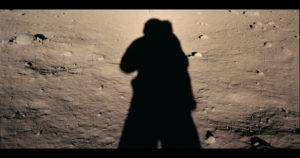
CLR: That’s really fascinating. You mentioned the voice of God that we hear at various points. I thought that some of the footage had, perhaps, a newscaster of the time, or was that all the public-affairs officers? I was trying to figure out if it was Walter Cronkite or somebody else.
TDM: Very early on, I knew that we could utilize the public-affairs officer who sat very near the flight director at mission control. What got broadcast to the public, at the time, in real time, were these public-affairs officers, that really dumbed down the mission for people like me and gave what was happening during the mission. They articulated it in layman’s terms. They worked, just like all the other flight-control or mission-control teams, in four-man teams, around the clock, 24/7.
And outside of that I knew there were two points at which I thought we could utilize Walter Cronkite. So, you’re right, you picked up on it. We did it at two points. One was the suiting-up shots. The minute I heard Walter Cronkite talking in this very off-the-cuff way … by the way, these were not prepared remarks, it was the morning of the launch and it was just this very poetic way in which he illustrated the events that were about to come. And I thought that juxtaposed well with the footage, which was some of the first footage I had seen, with the suiting-up shots. And you just see, on the faces of the astronauts, what lies in front of them, the gargantuan task in front of them. It just made sense to put Cronkite on that.And we use his audio again right before the landing, where he just articulates exactly what’s going on.
CLR: (laughs) Well, I’m glad to know I recognized the voice of my childhood, because at one point in my life, Cronkite was so familiar. One more question: could you just briefly discuss your instructions to composer Matt Morton for the score? Because it feels really organic to the original source material.
TDM: Yeah, Matt’s my longest collaborator. He and I go back to grade school. Typically, we do post-scoring for the films we make. Matt’s scored all of my films, and everything I’ve ever done. I’ve even asked him to do home videos for my kids. So, he’s just phenomenally talented. Before we even started the production, we were all doing deep dives into the research. And he said, “I want to do a period score with a modern composition. I want to only use instruments that were created pre-1969” … one of which was a Moog synthesizer, which he had no experience on. Moog themselves were reissuing a 1968, whatever, he can tell you the model number … IIIc, I believe, or IIc, something like that. And there were only 25 of them made. He got one and just learned how to use it.
We talked about doing a pre-score for this, just with the massive amount of material we had to wade through. It was exciting, to me, from an editing standpoint to have an hour-long composition and be able to whittle it down and try to get the tone right. So, that’s what we did. Obviously, he went back on some specific scenes and post-scored some things for emphasis. But, primarily, it was getting these amazing hour-, two-hour long compositions out of Matt. Lucky to say that, and I’m excited about this, there’s going to be a soundtrack-release tied in with the release this weekend. So, it’s a great testament to his work. And it’ll be as exciting as the film itself.
CLR: Well, I look forward to getting it. Congratulations on the film, Todd. It was really quite remarkable, and I wish you all good things with it.
TDM: I appreciate it, and thanks so much for your time.
